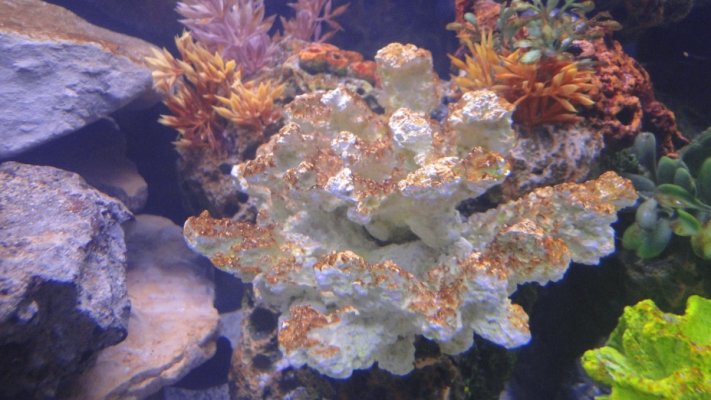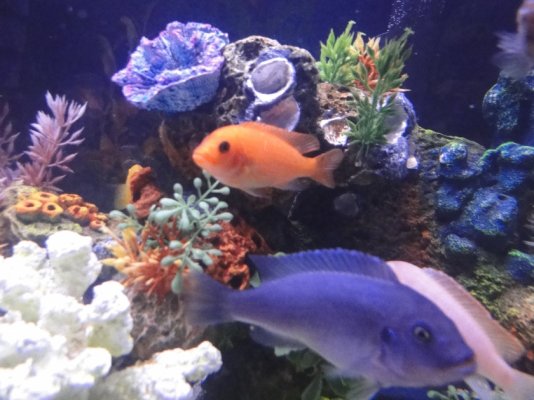Thanks so much HD -- I truly appreciate the lengthy input here. Let me address each of your points directly, as I think we're getting someplace now...
Okay -- so they're common in newly cycled aquariums, so is it possible my tank is beginning to actually cycle, five months into setup? I wish they would disappear as quickly as they arrived, on their own, but they actually came back stronger and more aggressively after I cleaned them out the first time...

hdultra: My understanding that a cycled tank, is that the water parameters are safe for the fish. As to were ammonia levels and nitrite levels are dissolved by beneficial bacteria turning into nitrates. Being Ammonia and Nitrites. And frequent water changes to keep the nitrates in check. No were did I read why they disappeared on there own. I get back into reading on that. But there are measures we can take to slow the progress of them. I'm currently taking all my study's of the subject and seeing if any of it works. But it's going to take time to see if the little brown


(diatoms) re appear.
_________________________________________________________________
I was discussing this with the member before you; we are running two rather large filters on a medium-sized 60 gallon aquarium -- an Aqueon QuietFlow 55 and an AquaClear 110, both good for moving over 800 something gallons per hour combined. Would you say this is inadequate filtration? There is PLENTY of water flow in this tank -- between the two filters' waterfall returns and the bubble walls on the back glass, the current and movement in the tank is ridiculous.
hdultra: Filtering is one thing, while water flow is another.
Filtration
This is were you hear the term (Mechanical Filtration) Mechanical Filtration collects the solid fish waste , uneaten food and particulate matter from decorations, live rock etc. These filters really only collect the solid waste.
And also they host Beneficial Bacteria.
I have two
Marineland 280's the have two slots for media. I slot (1) I put in the carbon filter. In slot (2) I put in a polishing pad to collect the very fine particles. It's like running a Hepa vacuum for water. I hoping it will collect the unattached diatoms in the water. JMO
External Canister Filter
And also I installed a Fluval 405.
Media selection is Bin (1).Carbon, Bin (2) Pre -filter Media and Nitrite And nitrate collection media Bin (3) Biomax For Beneficial Bacteria Bin (4) Ceramic Filter media and polishing pads.
Water Flow
Water flow is exactly as it say water flow. That say that good water flow through the tank will reduce the diatoms from clinging in the decor and other surfaces in a aquariums. To much water flow can stress the fish. So we must use caution with to much water flow. In other words you don't want you little fish swimming in the rushing Colorado River. For water flow I have the 2 Marinelands and (1) Fluval 405 I am hoping this is enough water flow well see.
I am beginning to suspect our tap water as well, as the diatoms came back almost immediately after removing them and topping off the tank with fresh (dechlorinated) water. Can you give me some more information about the API tap water filter? How expensive are we talking here?
hdultra:
Tap Water
I explained what was possibly in our tap water. I looked into the RO/DI systems the most of the salt guy's use. Which I want to get one. But I'm wanting to know if it is cost effective for freshwater and what unit would be best. I found out that RO/DI systems will remove electro lights and PH. The API comes with the additives to restore these properties.
But I did buy the
API Water Filter
This thing will remove all the contaminates from our water that causes (Diatoms). But as I said i'm still waiting to see the (Diatoms) that I removed by cleaning reappear.

Diatoms
Lighting
I am running a fluorescent strip light over the tank, without real plants, and I only have the lights on maybe three or so hours a day...would this affect diatoms?
hdultra: As far as I know lighting affects all algae forms. I put my lights on a timer.
I read somewhere that fish only need 8 hours of light. True or not I'm running mine at 10 hours instead of 12 to 14 hours a day.
Fort384: I also think that would COULD help would be to actually light the tank longer than 3-4 hours a day. Diatoms actually are sometimes a sign of not enough light, rather than too much.
Substrate
Are you suggesting that perhaps my GRAVEL is causing these?

hdultra: IMO Gravel holds most of the bacteria in our tanks. Good and bad.
Again IMO gravel needs to be cleaned once a month to remove sediments.
I'm sure that gravel host and feeds (Diatoms) But we don't want to destroy the Beneficial Bacteria in the bed. I think during the monthly tank maintenance is when I would clean the gravel. (Note) That I removed my gravel and put in Cichlid sand. I just vacuum of the surface every week during my water changes.
This comes back to the possibility that my tank is STILL cycling, or nearing completion...but this is FIVE MONTHS later...
hdultra:
Your Tank IS Already Cycled
Diatoms usually only show up after a newly tank has been cycled. Kinda like new tank syndrome.
I'll have to study why in newly setup tanks. Or someone can gives us that answer.
Decorations
Okay -- I did this the first time, as me and my wife removed all decor from the tank and physically washed each piece down with hot water to remove the diatoms. But I don't want to go through this again every time they pop up, as this was BACK BREAKING work.
hdultra: I agree with 100%. But if it appears you only have one option IMO to physically remove it. Using chemicals is not recommended, because it can do more harm than good. Most of the chemicals can affect your (Biological Filter) and or destroy it.
I think if we take steps to keep our water free of causing contaminates, that it will dramatically reduce (Diatoms) and even eliminate them.
RO/DI
Okay -- I am beginning to suspect that the silicates are the culprit here, and my tap water must be loaded with them. You say filtration is the best way to control this, but again, I am running two fairly large filters on this 60 gallon...do I actually need MORE? With regard to RO -- how does this work in comparison to tap water? How do I go about using RO water instead of my tap?
hdultra: DI systems remove all contaminates from the water to include all the things that cause (Diatoms) Phosphate Po4 And Silicates etc. I'm still wanting to hear from someone about those higher end systems. But for now I have the API. I was told that RO/DI systems will take out all the nutrients needed by freshwater fish. The API system has the additives to put back into the water. The API System is a DI system not RO.
Fort384 Said if someone was to do this to be very careful. It requires adding some minerals back in so that you have some buffering capacity and don't cause a pH crash.
Phosphate Po4
I didn't know this -- this sounds like a possibility. I was looking for something I could just add to the tank to make this easier; does the Seachem product just dump into the water, or is it a "filter" of some kind? And what about the sponge?
hdultra: I made reference to these products, but I have not read about the full affects they have on the biological system. I still need to educate myself on them. I'm sure someone here can tell us. As far as I know the sponge just absorbs Phosphates. I think that the API system will cover all those needs and more.
Fort384: I think running the phosban or something similar could help and may be worth a try. You can put it into a set of panty hose and throw it in your filter if you need some way to contain it. Just use new panty hose so you make sure there is no soap or laundry detergent in them.
I don't have live plants. All are fake. I didn't want our goldfish eating all the real plants!
hdultra: Nor do I. But it is said that live plants can benefit the decline of Diatoms.
But I have been advised that catfish will not mix with goldfish...
hdultra: I'm not sure on that one. Someone will have to educate us on this one.
Indeed, this was very helpful -- thanks so much again for posting this. I look forward to your feedback, and I will do some research on those products you mentioned.




